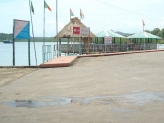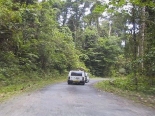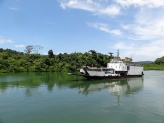Andaman Trunk Road
The vast separation of the Andaman and Nicobar group of islands from mainland India by sea, its unique biological wealth, strategic location and the fact that these islands are home for six primitive aboriginal tribes, instilled awe from all quarters of the world. The islands unique ecosystem is fragile, biodiversity is rich and endemism high hence utilization of its natural resources is restricted by various mechanisms. Owing to limited resources, environmental constraints and obvious compulsions, the islands had to depend on mainland India for almost anything to everything from essential commodities such as food, clothing and shelter material to health care facilities and services.
Large ships facilitate movement of these essential commodities between mainland and Port Blair ports. Once the bulk cargo meant for the entire population of A&N Island lands at Port Blair, small to medium capacity boats ferry these essential commodities by sea route to the consumers scattered in 38 inhabited islands. Large distance movement via sea route requires handling cargo at multiple points and takes lot of coordination, time and effort, apart from mercy of weather god. The loss in transit due to breakage, spillage and spoilage therefore becomes very high which is reflected in the selling price, which the logistically constrained islanders had to bear. The connectivity between Port Blair - North and Middle Andaman districts however saw a sea change with the construction of the Great Andaman Trunk Road (NH # 223) in 1970"s, known as ATR.
The 343 KM arterial road running from Port Blair, the capital town to Diglipur connects the four main islands of South Andaman, Baratang, Middle Andaman and North Andaman. Transportation, which used to take several weeks by sea route, takes a day or two by road. Moreover the ATR facilitated easy movement of peoples, health care facilities, essential commodities, goods and services any time during the year round, independent of weather conditions; a big sign of relief indeed. Though the ATR solved long pending connectivity issue, it however acquired the dubious distinction of the "most discussed" and "talked about" subject for completely different reason. The ATR, originally meant for facilitating easy movement of islanders, essential commodities, goods and services, a stretch of the road passing through Jarawa reserve between Jirkatang and Middle Strait, lately began to be used for ferrying tourists visiting Lime Stone Caves and Mud Volcano at Baratang. Such un-intended usage of the ATR brought a large number of curious visitors and along with them a set of problems galore for the hunting gathering aboriginal tribe named "Jarawa" living in the reserved forests.
Elaborate law and order measures had been put in place to minimize contact of outside travelers with the tribes along the 50 Km stretch of the ATR. Accordingly passage through this stretch of the ATR between Jirkatang and Middle Strait is allowed only in vehicles during day hours, in convoy, accompanied by armed police personnel and pilot. Still some of the tourists on their way pass pleasantries and or eatables etc to the Jarawas who line up along the ATR in anticipation.
In the past, owing to hostility and self proclaimed exile, Jarawas could survive outside contact for several millennia. But after the Enmei episode, not only did the Jarawas shed hostility they surprisingly began to seek contact with settler population residing alongside their territory. This facilitated administering health care facilities to the tribes afflicted by various infectious diseases. As a result their population, which on the downtrend reached 240 (as per 2001 census) increased to 380 persons as per 2011 headcount. During this time the volume of traffic on the ATR, particularly tourists increased so does unsolicited contacts. A group of Jarawas including ladies and children began to be seen alongside the ATR all the time, waiving hands and making gestures to attract the attention of passing travelers. Though local islanders travelling in the ATR seldom interact with the tribes, unsolicited friendly contact by visiting guests still continues.
Further there is a group of outlawed poachers constantly raiding their territory, robbing them of their resources. Bewildered, they fall prey to the lure of easy outside food on the ATR. With time, not only did Jarawas accepted outside clothing and eating habits but developed an appetite for the same. Experts warn, through this route, the classical hunting tribes are exposed to certain infections for which their immunity is next to nil. Several experts and reputed NGO"s raised to the occasion voicing need for protection of the tribes from outside interference. The catch however is that general opinion is built on the manifested behavioral pattern of a small group of Jarawas constantly cited along the ATR. Almost all experts and intellectuals end up suggesting closure of the ATR running through Jarawa reserve or realigning the ATR away from Jarawa reserve.The irony is mischief committed by some tourists, poachers and elite few, is being used as a means to garner support against ATR. The whole world is made to believe as if the ATR is used exclusively by tourists for human safari. Sadly experts, intellectuals, NGO"s and activists having ample knowledge and understanding of island conditions fail to appreciate the fact that ATR is also used by islanders for bonafide reasons. According to an estimate the daily to-and-fro traffic on the ATR include about 2500+ commuters, 22+ bus, 100+ four wheelers and 50+ goods vehicles. Of this, around 1200+ commuters and 60-70 four wheelers belong to tourists. Rest belongs to islanders. Secondly, Jarawa reserve starts from Jirkatang in South Andaman and ends at Parlobjig Camp No 15 in N&M Andaman, covering a distance of about 130 Km. But it is seen Jarawas line-up only at few points along the first 50 Km stretch of the ATR between Jirkatang and Middle Strait. Why is it so? Why is it that Jarawas do not show up in other parts of the ATR beyond Baratang? Perhaps, the answer is simple and known to every body. Jarawas has no issues with settler population and vice versa. They have been living together in perfect harmony for the last six decades. The problem emanates from those "unsolicited friendly contacts" by visitors and the poachers robbing their resource. The solution to the problem is rather simple and lies in strictly dealing with such offenders as per appropriate provisions available in the law. It's high time for everyone to appreciate the ATR is not a mere "convenience" but bare "necessity" for the islanders from rural South, North and Middle Andaman.
Seeing only one aspect of the issue and highlighting the pitfalls is nothing but a deliberate act to prejudice the national and international audience. Common sense will tell, any measure which does not take into account the needs of the local population is going to fall flat. Perhaps the UT Administration understands ATR is not any other road, but the "life line" of North and Middle Andaman.
Intellectual remedy that closing ATR will send Jarawas back to their way of life in jungles is like pressing undo button which unfortunately does not exist in real life situation. Suggestion to realign the ATR to exclude Jarawa reserve seems promising. But can anybody say for sure, the tribes will not migrate along the realigned route? Such a move would aggravate the situation by bringing Jarawas further close to the densely populated outside world. The tricky issue therefore demand careful handling. Suggestions based on academic competence may sound great but need not be practical. The media and the learned community need to accommodate islander"s point of view and suggest measures in larger interest. A holistic view taking into consideration the interest of the tribes as well as the specific needs of islanders is highly solicited.


